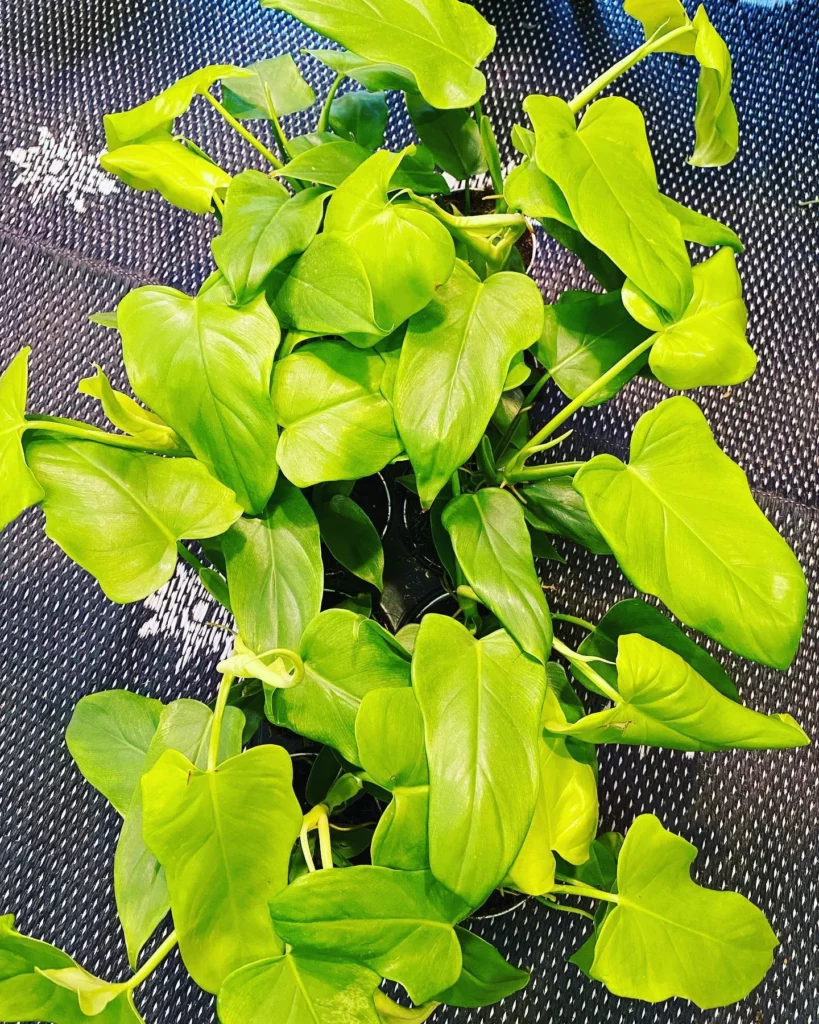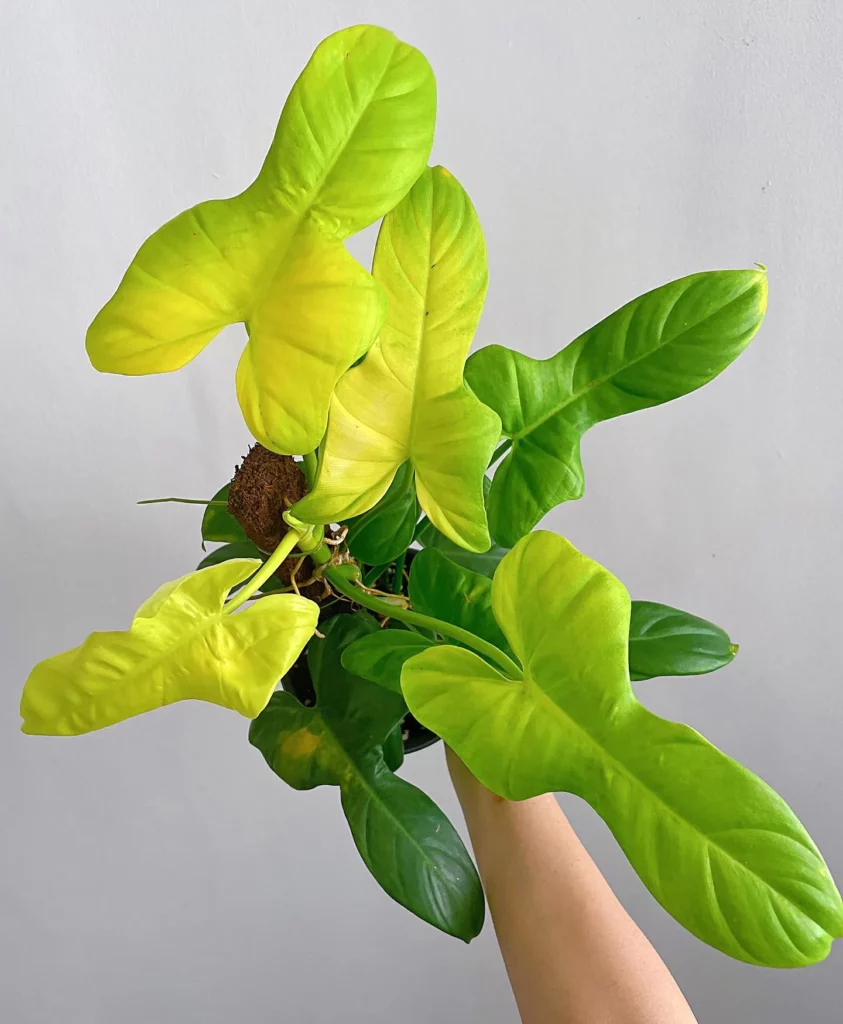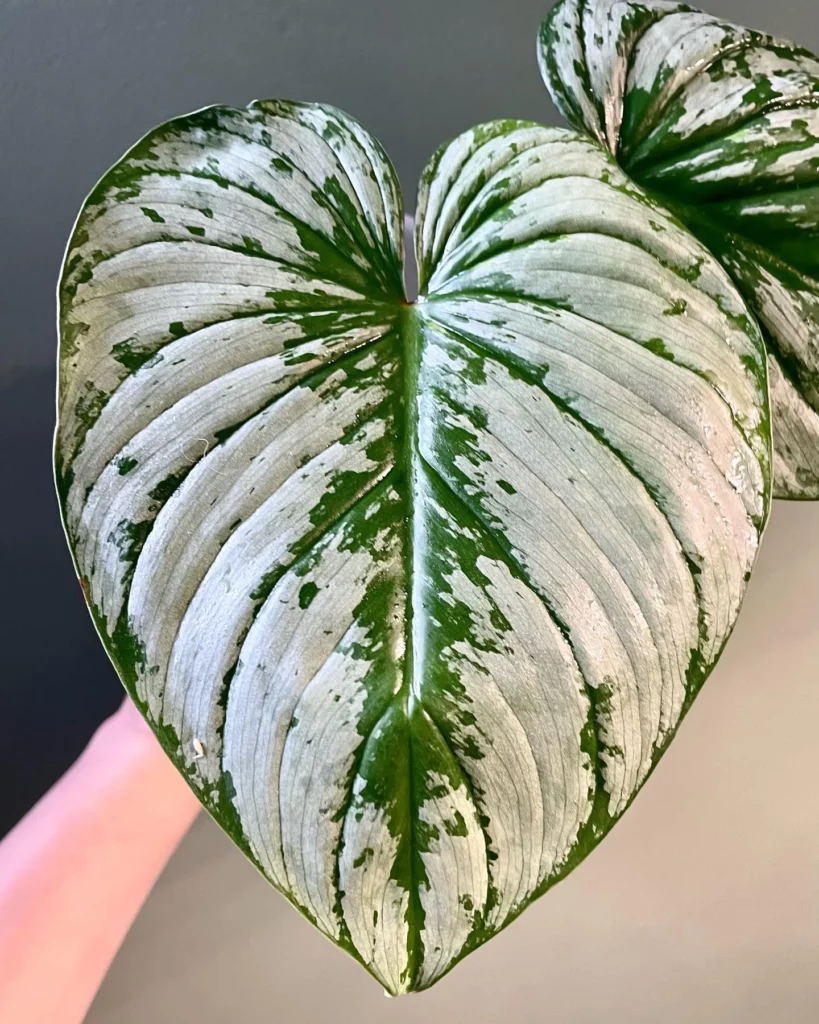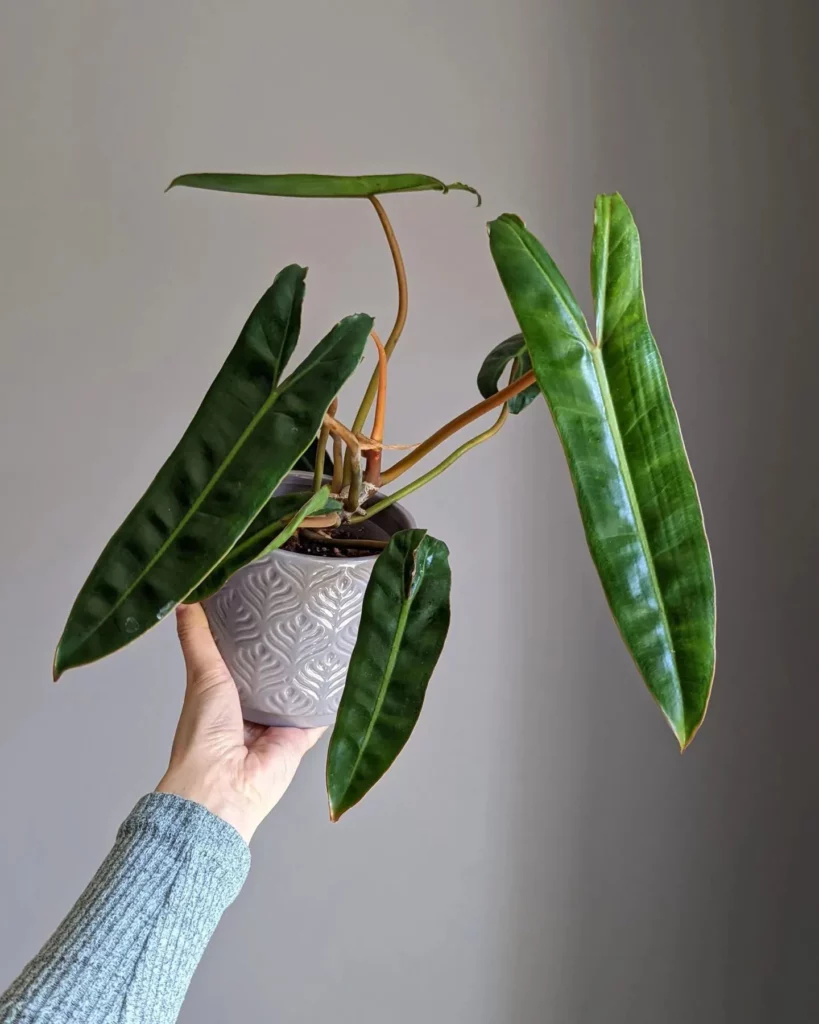The Philodendron Golden Violin is a visually stunning houseplant that is sure to catch the eye with its large, vibrant leaves. The leaves of this plant can grow up to an impressive 18 inches long, making it a true standout in any indoor space.
What sets the Philodendron Golden Violin apart is its unique foliage. The leaves start off with a striking golden-yellow color that adds a vibrant pop of color to your home. As the leaves mature, they transition to a beautiful light green shade, creating a captivating contrast that is sure to impress.
Appearance of Philodendron Golden Violin



The name Philodendron Golden Violin is derived from the shape of its foliage. Each leaf is gracefully elongated and tapers to a point, resembling the silhouette of a violin. This distinctive feature adds an element of elegance to the plant’s overall appearance, making it a true conversation starter.
To give you a better idea of its visual appeal, take a look at this stunning image of the Philodendron Golden Violin:
With its large, vibrant leaves, unique violin-shaped foliage, and captivating color transition, the Philodendron Golden Violin is a must-have for plant enthusiasts looking to enhance the appearance of their indoor spaces.
Light Requirements for Philodendron Golden Violin

The Philodendron Golden Violin is a houseplant that thrives in bright, indirect light. It is essential to place the plant in a room with windows nearby to ensure it receives some natural light. However, direct sunlight should be avoided as it can burn the foliage. The ideal location for the Philodendron Golden Violin is near a north or east-facing window, where it can enjoy bright, filtered light. If the plant is not receiving enough light, the leaves may become leggy and stretch towards the light source. On the other hand, if it is exposed to too much light, the leaves may turn yellow.
To maintain the optimal light conditions for your Philodendron Golden Violin, consider using sheer curtains or blinds to filter the sunlight. This will help protect the plant from direct exposure while still allowing it to receive adequate brightness. Additionally, rotating the plant periodically can ensure even light distribution and prevent any one side from receiving more light than the other.
Watering Philodendron Golden Violin



The Philodendron Golden Violin is a stunning houseplant that requires regular watering to maintain its health and vibrancy. Proper watering is essential for keeping the soil moist, which is crucial for the plant’s growth and development.
To determine when to water your Philodendron Golden Violin, it is recommended to check the top two inches of soil. If the soil feels dry to the touch, it is time to water the plant. Make sure to water thoroughly, allowing the water to evenly penetrate the soil.
However, it is important to avoid overwatering your Philodendron Golden Violin as it can lead to root rot. Overwatering occurs when the plant’s roots are constantly submerged in water, causing them to suffocate and eventually rot. To prevent this, it’s better to slightly underwater the plant than to overwater it. The Philodendron Golden Violin is more tolerant of slight dryness than excessive moisture.
When watering your Philodendron Golden Violin, pour water at its base, avoiding the foliage if possible. Wet leaves can invite diseases and encourage the growth of fungus. Additionally, make sure to use room temperature water, as cold or hot water can shock the plant’s roots.
Proper watering practices are key to maintaining the health and well-being of your Philodendron Golden Violin. By providing the right amount of moisture without overwatering, you can ensure that this stunning plant thrives in your indoor space.
Fertilizing Philodendron Golden Violin

Fertilizing is an important aspect of caring for your Philodendron Golden Violin plant. To promote healthy growth and vibrant foliage, it is recommended to fertilize the plant regularly during the growing season. A slow-release houseplant fertilizer can be used to provide the necessary nutrients.
Applying the fertilizer every three months is sufficient to support the plant’s growth. It is important to follow the instructions on the fertilizer package to prevent over-fertilization, which can damage the roots and foliage. Over-fertilization can lead to nutrient burn and other issues that may harm the plant’s overall health.
When fertilizing your Philodendron Golden Violin, make sure to evenly distribute the fertilizer around the base of the plant, avoiding direct contact with the stems or leaves. This will prevent the risk of burning the plant and ensure that the nutrients are absorbed properly.
Potting Philodendron Golden Violin



When potting the Philodendron Golden Violin, it is important to choose the right potting mix. Using a well-draining potting mix is crucial to prevent waterlogged soil, which can lead to root rot.
A recommended potting mix for the Philodendron Golden Violin includes a combination of premium potting mix, orchid bark, perlite, peat moss, and charcoal. This mixture provides the necessary drainage and aeration for the plant’s roots to thrive.
When selecting a pot for your Philodendron Golden Violin, opt for a container that has drainage holes at the bottom. These holes allow excess water to escape and prevent the roots from sitting in water for too long.
When potting the plant, ensure that the roots are covered with the potting mix, leaving space at the top for watering. Gently press the soil around the roots to secure the plant in place.
With the appropriate potting mix and a well-draining container, your Philodendron Golden Violin will have the optimal growing conditions for healthy root development and overall growth.
Propagation of Philodendron Golden Violin

The Philodendron Golden Violin can be easily propagated through stem cuttings. To begin the propagation process, carefully select a healthy stem with at least two nodes. Nodes are small bumps on the stem from which new roots will grow. Remove the lower leaves from the stem, making sure to leave at least one or two intact near the top.
Once you have prepared the cutting, you have two options for starting the rooting process: using water or a well-draining potting mix. If you choose to propagate in water, place the stem cutting in a clean container filled with filtered or distilled water. Ensure that the nodes are submerged in the water, while the upper leaves remain above the waterline. Remember to change the water regularly to prevent bacterial growth.
If you prefer to root the cutting in a potting mix, prepare a well-draining mixture of equal parts peat moss, perlite, and vermiculite. Fill a small pot with the mix, and create a small hole in the center using your finger or a pencil. Gently place the cut end of the stem into the hole, ensuring that the nodes are covered by the potting mix. Firmly press the mix around the base of the cutting to provide stability.
Whichever method you choose, make sure to place the cutting in a warm and humid environment. This will help stimulate root growth. Mist the leaves regularly to maintain high humidity levels. It may take a few weeks for the roots to develop, depending on the environmental conditions and the health of the cutting.
Once the roots have formed and are at least an inch in length, it is time to transplant the cutting into its own container. Choose a pot that is slightly larger than the root system of the cutting. Fill the new pot with a well-draining potting mix and create a small hole. Carefully transfer the cutting into the hole and gently firm the soil around it.
Tips for successful propagation of Philodendron Golden Violin:
- Choose healthy stems with at least two nodes.
- Remove the lower leaves, leaving a few near the top for photosynthesis.
- Use either water or a well-draining potting mix for rooting.
- Maintain a warm and humid environment for the cutting.
- Transplant the cutting into its own container once roots have developed.
Growth and Development of Philodendron Golden Violin



The Philodendron Golden Violin is a fast-growing plant that has the potential to reach impressive heights of up to 5 feet as it matures. This growth is accompanied by the production of larger and more striking leaves, adding to the plant’s visual appeal.
To ensure optimal growth, it is recommended to support the Philodendron Golden Violin by providing a trellis or pole for it to climb on. This helps mimic its natural habitat and encourages upward growth. Additionally, regular pruning can help maintain the desired shape and size of the plant, promoting healthy development.
The Philodendron Golden Violin’s ability to grow rapidly makes it an excellent choice for plant enthusiasts who enjoy watching their greenery thrive and flourish. With proper care and attention to its growth and development, this stunning plant can become a focal point in any indoor space.
No products found.
Pests and Diseases of Philodendron Golden Violin

The Philodendron Golden Violin, like many other plants, is vulnerable to pests and diseases that can compromise its health. Regular inspection and early intervention are key to maintaining the vitality of your plant.
Pests
Some common pests that can affect the Philodendron Golden Violin include:
- Mealybugs
- Scale
- Spider mites
- Thrips
- Aphids
To prevent infestations, regularly inspect your plant for signs of pest activity. Look for sticky residue, webbing, discolored or deformed leaves, and small insects.
If you notice any signs of pests, there are several measures you can take to treat and prevent them:
No products found.
- Remove visible pests manually with a gentle wipe or by using a soft brush.
- Isolate the affected plant to prevent the spread of pests to other plants.
- Introduce natural predators such as ladybugs to help control pest populations.
- Use organic pest control methods, such as neem oil or insecticidal soap, following the instructions carefully.
- Improve air circulation and reduce humidity levels, as some pests thrive in humid conditions.
Diseases
The Philodendron Golden Violin can also be susceptible to certain diseases, including:
- Root rot
- Erwinia blight
Root rot is typically caused by overwatering or poorly draining soil, leading to the decay of the plant’s root system. Erwinia blight, on the other hand, is a bacterial infection that causes yellowing, wilting, and rotting of the leaves.
To prevent diseases, ensure you provide appropriate care for your Philodendron Golden Violin:
- Use a well-draining potting mix to prevent waterlogged soil and root rot.
- Avoid overwatering and allow the top few inches of soil to dry out before watering again.
- Ensure proper ventilation and avoid excessive humidity, as these conditions can promote the development of diseases.
If your plant does develop signs of disease, promptly remove affected leaves or stems to prevent the spread of the infection. If necessary, consult a plant professional for further guidance and treatment options.
This plant requires your attention to maintain its health, but with proper care and vigilance, you can prevent and manage common pests and diseases that may affect your Philodendron Golden Violin.
Toxicity of Philodendron Golden Violin
The Philodendron Golden Violin is a stunning houseplant that adds beauty and vibrancy to any indoor space. However, it is important to note that this plant is considered toxic to both pets and humans if ingested.
The toxicity of the Philodendron Golden Violin is attributed to the presence of calcium oxalate crystals in its leaves. These crystals can cause swelling of the mouth, throat, and gastrointestinal tract when ingested.
For this reason, it is crucial to keep the Philodendron Golden Violin out of reach of children and pets to prevent accidental ingestion. Place it in a location where it cannot be accessed or consider hanging it from the ceiling to further ensure the safety of curious pets and young children.
If any ingestion of the Philodendron Golden Violin occurs, it is important to seek immediate medical attention. Contact a healthcare professional or veterinarian for guidance on the appropriate steps to take.
Risks of Ingesting Philodendron Golden Violin
- Swelling of the mouth, throat, and gastrointestinal tract
- Discomfort and pain
- Nausea and vomiting
- Difficulty breathing (in severe cases)
It is always better to err on the side of caution when it comes to the toxicity of houseplants, especially if you have young children or pets in your home. By taking necessary precautions and ensuring the Philodendron Golden Violin is kept out of reach, you can continue to enjoy its beauty without any health concerns.
Growing Tips
The Philodendron Golden Violin is a visually striking houseplant that adds a pop of color to any indoor space. With its bright golden-yellow leaves that mature to a light green shade, this plant is sure to catch the eye. Proper care is essential for keeping your Philodendron Golden Violin healthy and thriving.
- Light: It requires bright, indirect light to ensure optimal growth. Too much direct sunlight can harm the foliage, while too little light can result in leggy growth.
- Watering: Regular watering is necessary to keep the soil moist. Check the top two inches of soil and water whenever it feels dry, but avoid overwatering to prevent root rot.
- Potting: When potting, use a well-draining potting mix to ensure proper root health. A mixture of premium potting mix, orchid bark, perlite, peat moss, and charcoal can provide good drainage.
- Fertilizing: Applying a slow-release houseplant fertilizer every three months can supply the necessary nutrients for healthy growth. Avoid over-fertilizing, as it can damage the roots and foliage.
- Pests and Diseases: Regularly inspect your Philodendron Golden Violin for common pests like mealybugs, scale, spider mites, thrips, and aphids. Also, watch out for diseases such as root rot and Erwinia blight.
- Toxicity: Keep the Philodendron Golden Violin out of reach of children and pets, as it is toxic if ingested. It contains calcium oxalate crystals that can cause swelling and discomfort if consumed.
Conclusion
Providing the plant with the right light conditions is crucial for its growth. It thrives in bright, indirect light, so placing it near a window in a well-lit room is ideal. Avoid exposing it to direct sunlight to prevent leaf burn and discoloration.
Watering your Philodendron Golden Violin properly is also important to prevent both underwatering and overwatering. Check the top two inches of soil and water whenever it feels dry. Remember, it’s better to underwater than to overwater this plant as it is more tolerant of slight dryness than excessive moisture.
Lastly, be aware of the plant’s toxicity and take necessary precautions. The Philodendron Golden Violin contains substances that can cause swelling and discomfort if ingested by humans or pets. Keeping it out of reach and seeking medical attention immediately in case of ingestion is advised.
FAQ
How tall can the Philodendron Golden Violin grow?
The Philodendron Golden Violin can grow up to 5 feet tall.
What is the color of the leaves of the Philodendron Golden Violin?
The leaves of the Philodendron Golden Violin start off golden-yellow and mature to a light green color.
What is the light requirement for the Philodendron Golden Violin?
The Philodendron Golden Violin thrives in bright, indirect light. It should be placed in a room with windows nearby to ensure it receives some natural light.
How often should I water the Philodendron Golden Violin?
It is recommended to check the top two inches of soil and water whenever it feels dry. Regular watering is required to keep the soil moist.
How often should I fertilize the Philodendron Golden Violin?
The Philodendron Golden Violin benefits from regular fertilizing during the growing season. A slow-release houseplant fertilizer can be applied every three months.
What type of potting mix should I use for the Philodendron Golden Violin?
It is important to use a well-draining potting mix for the Philodendron Golden Violin. A mixture of premium potting mix, orchid bark, perlite, peat moss, and charcoal can provide good drainage and aeration for the plant’s roots.
How can I propagate the Philodendron Golden Violin?
The Philodendron Golden Violin can be propagated through stem cuttings. Select a healthy stem with at least two nodes and remove the lower leaves. Place the cutting in water or a well-draining potting mix until roots develop.
How can I encourage growth in the Philodendron Golden Violin?
To encourage growth, provide a trellis or pole for the Philodendron Golden Violin to climb on. Regular pruning can also help maintain the desired shape and size of the plant.
What are the common pests and diseases that affect the Philodendron Golden Violin?
The Philodendron Golden Violin may be susceptible to pests such as mealybugs, scale, spider mites, thrips, and aphids. It can also be affected by diseases like root rot and Erwinia blight.
Is the Philodendron Golden Violin toxic?
Yes, the Philodendron Golden Violin is considered toxic to both pets and humans if ingested. It contains calcium oxalate crystals that can cause swelling of the mouth, throat, and gastrointestinal tract.




